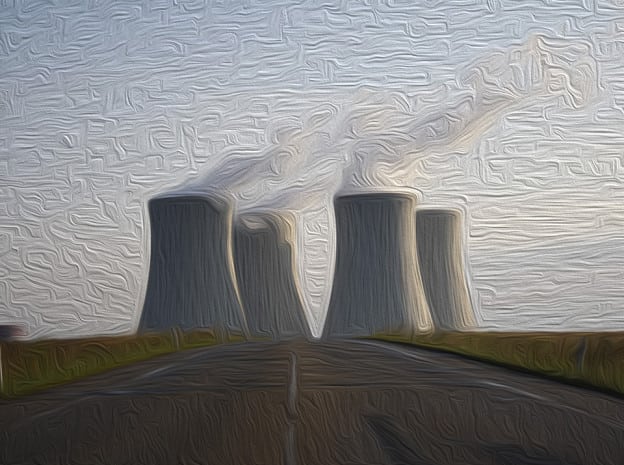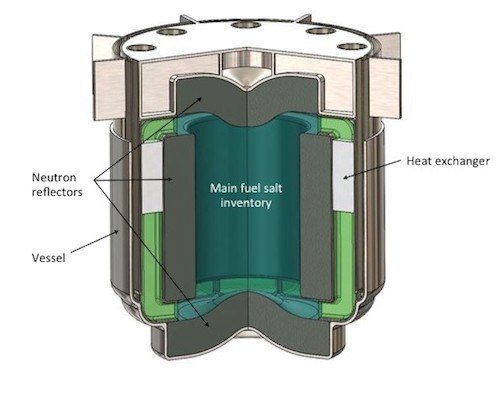Administration, NRC, Nuclear Industry Look Ahead to Uncertain Territory
Credit to Author: Kennedy Maize| Date: Mon, 02 May 2022 04:13:00 +0000

The Biden administration is fully behind development of new nuclear power technology. It is encouraging the U.S. Nuclear Regulatory Commission (NRC) to look at “new approaches to regulation” as advanced reactor designs get reviewed. That was the message Energy Secretary Jennifer Granholm delivered during the NRC’s annual Regulation Information Conference, an online event in early March.
At least in the U.S., it seems that the conventional liquid water reactor technology, using water as a coolant and neutron moderator with solid metal fuel, the key to nuclear power technology around the world since the 1950s, has hit an economic and technical wall. That’s particularly true for large, central-station generation, although there is some hope for small modular light water reactors. In any case, the U.S. Nuclear Regulatory Commission (NRC) believes its regulatory tasks are likely to change.
 |
1. Jennifer Granholm, former Democratic governor of Michigan, is the second woman to head the energy department. The first was Hazel O’Leary, the Clinton administration’s first secretary of energy, who served from 1993 to 1997. Source: U.S. Department of Energy (DOE) |
In a brief live virtual appearance at the NRC meeting, U.S. Secretary of Energy Jennifer Granholm (Figure 1) touted the benefits of nuclear technology as a reliable source of electric power, and “a proven solution to climate change.” She said, “We need everyone here to speak up about the benefits of nuclear.” Lawmakers in Congress, she said, “have to hear that.” The U.S., she said, needs to “add more clean, safe, secure nuclear power.” The administration also wants to keep existing reactors operating.
The Nuclear Industry Craves a Smoother Process
The nuclear industry, which has long complained about NRC regulation, welcomes this approach. The Nuclear Energy Institute, the industry’s lobbying group, says on its website, “It’s time to revisit regulations and remove roadblocks to improve and streamline the operations of our nuclear fleet. With right-sized regulations, we can remove barriers to innovation and implement newer, even safer nuclear technology that lay the groundwork for the next generation of carbon-free technology.” It was a message many who attended the virtual conference were happy to hear.
The administration has backed its rhetoric with money. While the U.S. Department of Energy (DOE) has been touting a $160 million advanced reactor development program launched in the Trump administration, on March 9, the same day Granholm spoke to the NRC confab, the DOE rolled out a $6 billion “Civil Nuclear Credit Program,” designed to aid existing, economically threatened operating light water reactors.
The DOE issued formal notices of intent and requests for information to implement provisions of the administration’s trillion-dollar 2021 infrastructure program aimed at preserving existing nuclear generation. In a DOE press release, Granholm said, “The Bipartisan Infrastructure Law makes this all possible by allowing us to leverage our existing clean energy infrastructure, strengthen our energy security and protect U.S. jobs. DOE is facilitating the development of next-generation technologies that can ultimately lower emissions and bolster the clean energy workforce.”
Looking to the Future
The NRC’s annual gabfest and deep dive into nuclear technology and regulatory issues focused on the future, as existing light-water reactor technology has hit what appear to be economic and technical dead ends. The theme of the NRC conference was “preparing for tomorrow.”
Arshad Mansoor, head of the Electric Power Research Institute (EPRI), asked, “Are we ready for the future?” and highlighted France’s decision to revitalize its once aggressive, recently sleepy, nuclear power program, and the decision by West Virginia, once the nation’s largest coal producer, to repeal its long-standing prohibition of nuclear power plants in the Mountaineer State.
Mansoor said the U.S. “is making progress” in reducing carbon dioxide emissions, down from 2005–2020 by 35%. In the decade ahead, he said, “The largest carbon-free energy source needs to be there,” meaning nuclear. Atomic power, he said, “Is not just a clean energy source, but a source of capacity and resiliency.” But the U.S. needs a “reimagining” for nuclear, in terms of following load, and of supplying power to produce hydrogen, a future fuel, and ammonia, long important as an agriculture fertilizer, but also a potentially potent energy carrier.
Today, natural gas is typically used to make hydrogen, which then is combined with nitrogen through the Haber-Bosch process to produce ammonia (NH3). However, nuclear power could be used to produce hydrogen through high-temperature electrolysis (HTE). HTE systems use the heat and steam generated from a nuclear plant, requiring much less electricity than traditional electrolysis.
Artificial Intelligence and the Nuclear Power Industry
One of the topics the NRC conference addressed in a technical session looking at the future of nuclear regulation was “Am I a Robot?—How Artificial Intelligence and Machine Learning are Impacting the NRC and Nuclear Industry.” It was the leadoff technical session at the meeting, as it is a nearer-term future issue, trying to find new tools to deal with operating plants. The agency is gearing up to deal with regulatory issues associated with artificial intelligence (AI), and how industry is adapting to the rise of advanced digital computer technology for plants that were built, and in some ways still operate, in an analog world.
Luis Betancourt of the NRC’s Office of Nuclear Reactor Regulation noted that the industry is already researching this topic, and the NRC “must be prepared to evaluate” what the nuclear industry is doing. He said the agency is developing a strategic plan “to better position the agency in AI decision-making,” and has assembled an “interdisciplinary team” from across the agency to develop the plan.
Betancourt said that the NRC held workshops in 2021 on data science and AI applications to begin that process. He said the NRC hopes to publish a draft of the strategic plan in the Federal Register this summer, followed by a public meeting on the draft. A final AI strategic plan, he said, is “expected by fall 2022.”
Gene Kelly, senior manager at Baltimore-based Constellation, a former Exelon subsidiary spun off into a free-standing company that now owns all of Exelon’s former nuclear plants, expressed caution about embracing AI and machine learning (ML). His PowerPoint presentation was titled “Stay in Your Lane, Dude. Automating Industry Processes using AI/ML.”
He said Constellation has started looking at AI with small applications. He advised against “big moon shots,” preferring instead “small bites of the elephant.” Kelly added, “We don’t have deep learning algorithms yet. We are trying to stay small and get some wins.” Kelly said Constellation is not even remotely thinking about operating any system with AI. Rather, they see AI today as a “decision support tool, not a decision-making tool.”
One of the touted applications of AI and ML is “online learning.” Benjamin Schumeg, an AI expert at the Department of Defense, was cautious about online learning. He observed that it is “something that is going to be far off. It’s going to be a while. It’s very difficult thinking about systems that can adjust themselves.”
Molten Salt Reactors
Another technical session examined a revolutionary issue that could be farther out on the nuclear power horizon but is gaining traction among some nuclear advocates today: molten salt reactors (MSRs). The NRC session was accurately titled, “Molten Salt Reactors: Rethinking the Fuel Cycle.” Molten salt technology, which combines reactor coolant and fuel in a liquid, graphite or heavy-water moderated, could force significant changes in how the commission regulates power plants from design, siting, operations, waste management, and decommissioning.
John McKirgan of the NRC’s Office of Material Safety and Safeguards noted that the agency has been working with Terrestrial Energy since 2019 on its MSR design. Terrestrial Energy has more than $68 million in venture capital investment and features former Secretary of Energy Ernie Moniz as an advisor. Several other developers have been working on molten salt designs.
Patricia Paviet of the DOE’s Pacific Northwest National Laboratory outlined some of the technical and regulatory issues facing development of MSR technology, including purification of the salts, production, and fabrication at large scale; fuel qualification standards where “standards do not exist”; and disposal requirements. The U.S. Environmental Protection Agency is also likely to be involved in the regulation of MSRs.
MSRs have an old and short history in the U.S. The technology first drew attention in the 1950s, when the Atomic Energy Commission was looking for a propulsion system for a nuclear-powered bomber aircraft. The technology promised the very high temperatures and energy density needed, but an experiment with a 2.5-MWth reactor hit a dead end when the U.S. canceled its nuclear bomber program. In the 1960s, Oak Ridge National Laboratory (ORNL), under the direction of legendary atomic pioneer Alvin Weinberg, developed a 7.5-MWth reactor, which also never advanced beyond the experimental stage, much to Weinberg’s regret.
Writing in POWER magazine in 2018, French nuclear expert Jean-Baptiste Peu-Duvallon commented, “While the MSR concept is quite simple on paper, its industrialization is quite complex. Because the coolant is a mixture of chemicals rather than water, it provokes the release of significant quantities of tritium, which must be removed continuously. It generates other issues too, such as speedy corrosion of standard alloys, and also core lifetime issues when the coolant is moderated with graphite.”
 |
2. The molten chloride fast reactor design uses liquid chloride salts as the coolant and fuel that flows through the reactor core—allowing the fission to directly heat the salts. The mixture is then circulated through a heat exchanger to a coolant chloride salt loop that can be used for process heat, thermal storage, or electricity generation. Source: DOE |
Peu-Duvallon continued, “Because no MSRs have operated after the early 1970s, none of the technical solutions currently proposed to solve the outstanding issues have actually been tested.” However, that could change very soon. Southern Company is partnering with TerraPower to develop a molten chloride fast reactor (MCFR, Figure 2) that uses liquid salts as both a coolant and fuel. The DOE already invested more than $45 million in cost-shared funds for the project to further identify and test materials used in the reactor.
The project team reported in late November last year that it was in the final stages of the design phase for an integrated effects test in support of an MCFR program. They are working with ORNL, Idaho National Laboratory, Vanderbilt University, and EPRI to accelerate the development and deployment of a commercial MCFR. They expect to begin testing in a $20 million integrated effects test facility this year. The NRC session on MSRs concluded with this observation, “Molten salt reactor concepts are on a fast track.”
—Kennedy Maize is a veteran energy journalist and long-time contributor to POWER magazine.
The post Administration, NRC, Nuclear Industry Look Ahead to Uncertain Territory appeared first on POWER Magazine.